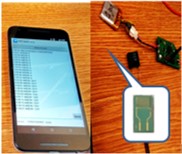¤ Results
2020 –
The main activities that we focused on during 2020 were:
- Technology optimisation;
- Environmental sensors integration;
- Final testing and validation of the portable gas sensors.
 |
 |
Sensors response to variable CO concentrations |
CO Sensors with the mobile measurement platform |
Dissemination:
- Savin, M.; Mihailescu, C.-M.; Avramescu, V.; Dinulescu, S.; Firtat, B.; Craciun, G.; Brasoveanu, C.; Pachiu, C.; Romanitan, C.; Serban, A.-B.; Ion, A.C.; Moldovan, C. A New Hybrid Sensitive PANI/SWCNT/Ferrocene-Based Layer for a Wearable CO Sensor, Sensors 2021, 21, 1801. https://doi.org/10.3390/s21051801
- Saoutieff, E.; Polichetti, T.; Jouanet, L.; Faucon, A.; Vidal, A.; Pereira, A.; Boisseau, S.; Ernst, T.; Miglietta, M.L.; Alfano, B.; Massera, E.; De Vito, S.; Bui, D.H.N.; Benech, P.; Vuong, T.-P.; Moldovan, C.; Danlee, Y.; Walewyns, T.; Petre, S.; Flandre, D.; Ancans, A.; Greitans, M.; Ionescu, A.M. A Wearable Low-Power Sensing Platform for Environmental and Health Monitoring: The Convergence Project, Sensors 2021, 21, 1802. https://doi.org/10.3390/s21051802
2019 –
The CO sensors were fabricated during 2019. The sensitive layer was further optimised, so that to maximise the electric response to the added carbon monoxide concentrations. The sensors showed a good response for CO concentrations of 10 ppm.
The wearable pressure sensor was also designed, fabricated and tested. The device includes several transducers distributed along a microfluidic channel, in order to detect static and dynamic loads. The transducers are made of Au and they were deposited on a flexible substrate.
Patent registration:
- Savin Mihaela, Carmen Mihailescu, Carmen Moldovan, Marian Ion, PANI conductive ink fabrication method, OSIM reg. no. A/ 00506/ 21.08.2019
2018 –
The CO sensor’s layout and the masks set have been developed during the second stage of the project. Also, the technology flow (the technological steps required for the fabrication of the sensor) have been defined.
It has been decided, in agreement with the European partners, that the sensor will require a fixed working temperature, slightly above the room temperature (50 °C). Therefore, the sensor will be upgraded with a Joule heater, placed on the bottom side of the chip. Initial mechanical and electrical simulations were deployed, in order to optimise the heater’s geometry and parameters for the required heating of the sensor’s substrate.
From the sensing element’s point of view, initial tests for the CO sensors functionalisation were performed, by depositing PANI (polyaniline) on the interdigitated electrodes (both on silicon and alumina substrate).
 |
 |
| Temperature distribution within the CO sensor (simulation) |
Cyclic voltammetry of the PANI deposition |
Dissemination:
- Elise SAOUTIEFF, Adrien FAUCON, Sébastien BOISSEAU, Thomas ERNST, Tiziana POLICHETTI, Maria Lucia MIGLIETTA, Brigida ALFANO, Ettore MASSERA, SaverioDEVITO, Sylvain PETRE, Thomas WALEWYNS, Nicolas ANDRE, Denis FLANDRE, Carmen MOLDOVAN, Silviu Dinulescu, Modris GREITANS, Aldo ROMANI, Sensors platform for health and environmental monitoring, Workshop Nano2sense „ Semi-conducting Nanomaterials for Health, Environment and Security Applications", Grenoble, Nov. 6th, 2018
2017 –
During 2017, IMT – Bucharest contributed to the European Flag-Era.NET project by carrying out several research activities, mostly related to the detailed technical specifications of the portable devices to be developed:
- Identification of technical requirements and specifications for portable, low power physiological sensors;
- Identification of requirements and technical specifications for wearable CO sensors;
- Planning the validation and testing of the devices according to the proposed medical scenarios.
The main types of physiological parameters that can be measured with the sensors have been defined: blood pressure, heart rate, respiratory rate, body temperature. The specific technology for each of the four parameters have been defined and presented.
Preliminary tests for the technical specifications of the wearable CO sensors have been carried out. The sensors on ceramic substrate responded better than the ones on silicon substrate.
The CO sensor that will be developed by IMT-Bucharest will be integrated on the sensors platform developed by the CONVERGENCE European consortium.
|
